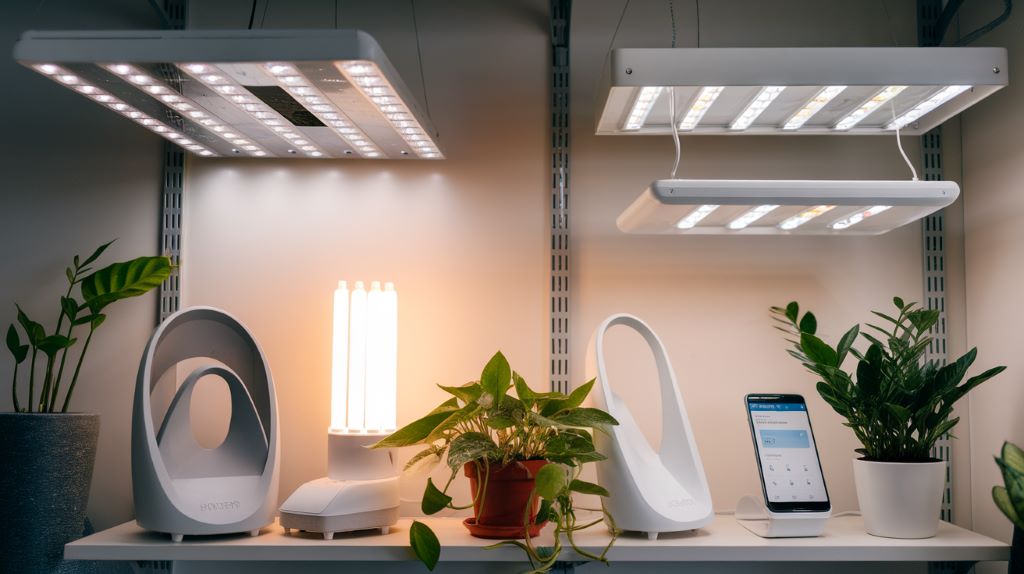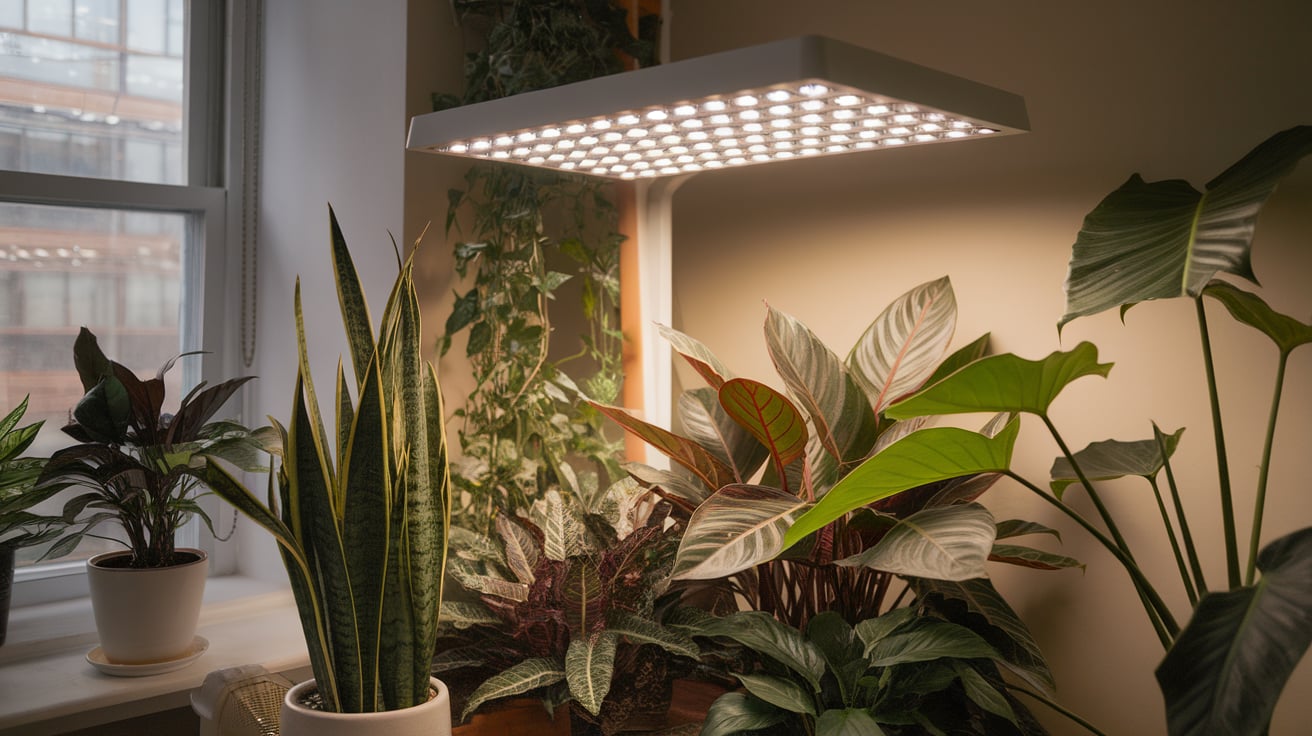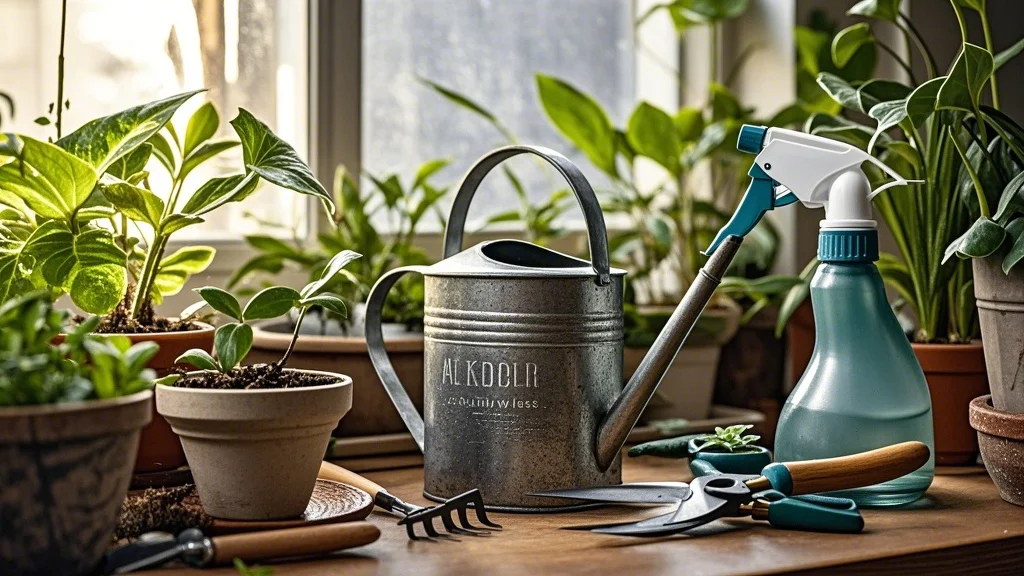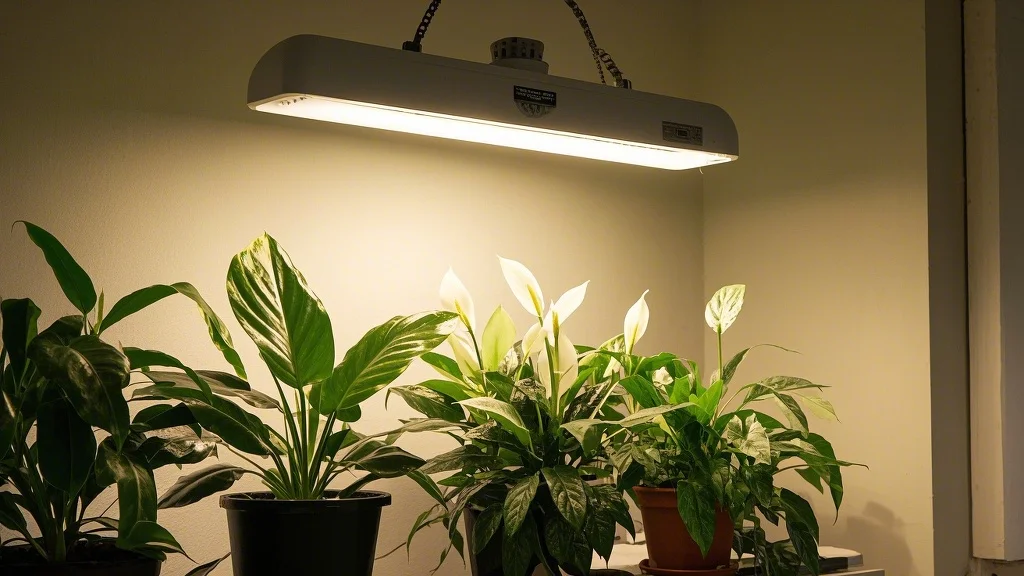Living in an urban apartment with limited natural light doesn’t mean you have to give up on your dream of lush, thriving houseplants. Many city dwellers face the challenge of north-facing windows, neighboring buildings blocking sunlight, or deep rooms where light barely reaches. The solution? Grow lights—artificial lighting specifically designed to provide plants with the light spectrum they need for photosynthesis and healthy growth.
Today’s grow light technology has evolved far beyond the harsh, energy-consuming options of the past. Modern LED grow lights are efficient, affordable, and designed with apartment aesthetics in mind. Whether you’re nurturing tropical plants that demand bright indirect light or simply trying to keep your pothos alive in a dim corner, the right grow light can transform your plant care routine and expand your indoor gardening possibilities.
In this comprehensive guide, we’ll explore everything you need to know about supplementing natural light in low-light spaces, from understanding light requirements to selecting the perfect grow light for your specific situation.
Contents
- 1 Understanding Plant Light Requirements
- 2 Types of Grow Lights for Apartment Settings
- 3 Top Grow Light Picks for Apartment Dwellers
- 4 Setting Up Grow Lights in Your Apartment
- 5 Balancing Natural and Artificial Light
- 6 Common Grow Light Mistakes to Avoid
- 7 DIY Grow Light Solutions
- 8 Measuring Success: Is Your Grow Light Working?
- 9 Conclusion
- 10 FAQs
Understanding Plant Light Requirements
Before investing in grow lights, it’s important to understand what your plants actually need.
The Light Spectrum and Plant Growth
Plants primarily use red and blue wavelengths from the light spectrum for photosynthesis:
- Blue light (400-500nm): Promotes vegetative growth, leaf development, and compact growth habits
- Red light (600-700nm): Stimulates flowering, fruiting, and stem elongation
- Full spectrum: Mimics natural sunlight and provides a balanced light diet for most plants
Light Intensity and Duration
Plants don’t just need the right type of light—they need enough of it:
- Low-light plants (pothos, ZZ plants, snake plants): 50-250 foot-candles
- Medium-light plants (philodendrons, peace lilies): 250-1,000 foot-candles
- High-light plants (succulents, citrus, flowering plants): 1,000+ foot-candles
Most houseplants need 12-16 hours of light daily, with 8 hours of darkness for respiration and other metabolic processes.
Signs Your Plants Need More Light
Your plants will tell you when they’re light-deprived:
- Leggy, stretched growth reaching toward light sources
- Smaller new leaves compared to older growth
- Slow or stalled growth
- Pale, yellowing leaves (not due to nutrient deficiencies)
- Reduced or absent flowering
- Leaf drop, especially lower leaves
Types of Grow Lights for Apartment Settings

LED Grow Lights
Pros:
- Energy-efficient (up to 60% more efficient than fluorescents)
- Long-lasting (50,000+ hours)
- Run cool, reducing fire hazards
- Available in slim, decorative designs suitable for apartments
- Can be full-spectrum or targeted wavelengths
Cons:
- Higher upfront cost
- Quality varies significantly between brands
Best for: Long-term use, serious plant enthusiasts, growing light-hungry plants
Fluorescent Grow Lights
Pros:
- Affordable initial investment
- Good spectrum for foliage plants
- Available in various sizes and configurations
- T5 high-output options provide excellent intensity
Cons:
- Less energy-efficient than LEDs
- Bulbs need replacement every 1-2 years
- Contain small amounts of mercury
- Bulkier fixtures
Best for: Budget setups, temporary solutions, seedling starting
Compact Fluorescent Lights (CFLs)
Pros:
- Fit standard light fixtures
- Inexpensive and widely available
- Good for supplementing light for 1-2 plants
Cons:
- Lower intensity than dedicated grow lights
- Limited coverage area
- Less efficient than LEDs
Best for: Single plants, budget solutions, using existing fixtures
Smart Grow Lights
Pros:
- Programmable schedules
- Remote control via smartphone
- Some offer spectrum adjustability
- Integration with smart home systems
Cons:
- Premium pricing
- Potential connectivity issues
- May require Wi-Fi to function properly
Best for: Tech-savvy gardeners, those with complex schedules, precision growing
Top Grow Light Picks for Apartment Dwellers
Best Overall: Soltech Aspect LED Grow Light
The Soltech Aspect combines performance with aesthetics, featuring a minimalist pendant design that looks like a stylish light fixture rather than utilitarian growing equipment. Its full-spectrum light closely mimics natural sunlight while providing the intensity needed for most houseplants.
Specifications:
- Full spectrum white light
- 20W power consumption
- Coverage: 3′ x 3′ area
- Lifespan: 50,000+ hours
- Dimmable options available
- Price range: $75-$150
Why we love it: The Aspect’s clean design means you won’t have to sacrifice your apartment’s aesthetic for healthy plants. The light quality is excellent, with a color temperature that enhances both plant growth and the visual appearance of your space.
Best Budget Option: GooingTop LED Grow Light
For those just testing the waters with grow lights, this clip-on option provides excellent value without a significant investment.
Specifications:
- 3 light modes (red, blue, or combined)
- 3 brightness levels
- Flexible gooseneck design
- Timer function (3/9/12 hours)
- USB powered
- Price range: $15-$25
Why we love it: The clip-on design requires no installation, making it perfect for renters. Despite its affordable price, it includes timer functions and adjustable settings typically found in more expensive models.
Best for Serious Plant Collections: Spider Farmer SF-1000 LED Grow Light
When you’re growing numerous plants or light-hungry specimens, this powerful panel delivers professional-grade results.
Specifications:
- Full spectrum white light with enhanced red
- 100W power consumption
- Coverage: 2′ x 2′ for flowering plants, 3′ x 3′ for vegetative growth
- Dimmable driver
- Fanless design for silent operation
- Price range: $150-$200
Why we love it: While more utilitarian in appearance, this light provides commercial-grade growing power in a relatively compact package. The silent operation and dimmable feature make it apartment-friendly despite its professional capabilities.
Best for Aesthetics: Soltech Vita LED Grow Bulb
For those who want to hide their grow lights in plain sight, these bulbs fit standard E26 fixtures while providing plant-friendly light.
Specifications:
- Full spectrum white light
- 10W power consumption
- Fits standard light fixtures
- 15,000+ hour lifespan
- Price range: $30-$45 per bulb
Why we love it: These bulbs allow you to transform existing decorative lamps and fixtures into grow lights without anyone knowing the difference. The light appears as pleasant white light to humans while providing the spectrum plants need.
Best Smart Option: Wyze Color Bulb
This smart bulb can be programmed to provide the right light spectrum for plants while integrating with your smart home setup.
Specifications:
- Adjustable color temperature and brightness
- 16 million color options
- Voice control compatible
- Scheduling via app
- 25,000 hour lifespan
- Price range: $15-$25 per bulb
Why we love it: While not marketed specifically as a grow light, when set to the right color temperatures, these smart bulbs can effectively supplement light for low to medium-light plants. The scheduling feature ensures consistent light cycles even when you’re away.
Setting Up Grow Lights in Your Apartment
Placement and Distance
The effectiveness of your grow light depends significantly on proper placement:
- Distance from plants: Most LED grow lights should be positioned 12-24 inches above plants. Fluorescents can be closer at 6-12 inches.
- Coverage area: Ensure the light covers all plants evenly; rotating plants periodically helps ensure balanced growth.
- Light angle: Position lights to mimic the sun’s natural angle when possible.
Mounting Options for Renters
Apartment dwellers often need non-permanent solutions:
- Clip-on lights: Perfect for shelves, tables, or desks
- Floor lamps: Adjustable options can be positioned over plant groupings
- Tension rods: Create overhead mounting without drilling
- Furniture-mounted options: Attach to bookcases or entertainment centers
- Adhesive hooks: Use with lightweight fixtures and cord management
Creating a Timer System
Consistency is key for plant growth:
- Simple outlet timers: Affordable and reliable for basic on/off scheduling
- Smart plugs: Add scheduling to non-smart grow lights
- Integrated timers: Many modern grow lights include built-in timing functions
- Smart home integration: Connect compatible lights to systems like Alexa or Google Home
Aim for 12-16 hours of light daily, ideally coinciding with natural daylight hours to maximize overall light exposure.
Balancing Natural and Artificial Light
Assessing Your Natural Light Situation
Before supplementing with grow lights, understand what you’re working with:
- Identify your exposure: North-facing windows receive the least light, south-facing the most (in the Northern Hemisphere).
- Measure light levels: Light meter apps can help quantify available light throughout the day.
- Track seasonal changes: Winter may require more supplemental lighting than summer.
- Note obstructions: Buildings, trees, or awnings can significantly reduce light penetration.
Complementary Placement Strategies
Strategic positioning maximizes both natural and artificial light:
- Layered approach: Place lower light plants under grow lights, higher light plants near windows
- Reflective surfaces: Mirrors or white walls can bounce both natural and artificial light deeper into rooms
- Rotating schedule: Move plants between window areas and grow light stations weekly
- Seasonal adjustments: Increase artificial light during shorter winter days
Light Duration and Scheduling
Create a lighting schedule that works with your natural light patterns:
- Morning boost: Run grow lights in early morning before natural light strengthens
- Evening extension: Extend daylight hours with grow lights after sunset
- Cloudy day supplement: Use light sensors or weather apps to increase artificial light on overcast days
- Seasonal adjustment: Program longer artificial light periods during winter months
Common Grow Light Mistakes to Avoid
Insufficient Light Intensity
One of the most common errors is choosing lights that don’t provide adequate intensity:
- Solution: Check the PPFD (Photosynthetic Photon Flux Density) ratings when available, or lumens as a secondary measure. More is generally better, as you can always increase distance to reduce intensity.
Improper Distance
Positioning lights too far away reduces effectiveness; too close can damage plants:
- Solution: Follow manufacturer guidelines for hanging heights and watch for plant responses. Leaves curling or developing brown spots may indicate light burn from too-close placement.
Inconsistent Light Cycles
Erratic on/off schedules confuse plants and disrupt growth:
- Solution: Use reliable timers and maintain consistent schedules. Sudden changes in light duration can stress plants.
Neglecting Light Quality
Not all “grow lights” provide the right spectrum:
- Solution: Choose full-spectrum options for general growing, or lights with appropriate red/blue balance for specific growing goals.
Forgetting Human Comfort
Harsh purple grow lights can make living spaces uncomfortable:
- Solution: Consider white full-spectrum LEDs that support plant growth while providing pleasant ambient light for humans.
DIY Grow Light Solutions
Budget-Friendly Setups
Creating effective grow light systems doesn’t have to break the bank:
- Shop light conversion: Standard T5 or T8 fluorescent shop lights with daylight bulbs (5000-6500K) make excellent plant lights
- Clamp light clusters: Multiple inexpensive clamp lights with LED or CFL bulbs can create effective growing stations
- Repurposed furniture: Convert bookcases into growing shelves with strip lights mounted under each shelf
Enhancing Effectiveness
Simple additions can improve light efficiency:
- Reflective materials: Line walls or create reflectors with aluminum foil, mylar, or white paint
- Light movers: DIY pulley systems can move lights to cover more plants with fewer fixtures
- Light shelves: White shelves placed below windows bounce natural light deeper into rooms
Aesthetic Integration
Make grow lights part of your decor:
- Decorative covers: Basket-style lampshades can disguise utilitarian fixtures
- Plant pedestals: Raise plants to light sources with decorative stands
- Integrated furniture: Build or modify plant stands with hidden light fixtures
Measuring Success: Is Your Grow Light Working?
Plant Response Indicators
Your plants will show whether they’re receiving adequate light:
- Positive signs: Compact growth, vibrant color, new leaves, flowering
- Improvement signs: Reduced legginess, stronger stems, larger leaves than before
- Continuing issues: Stretching toward light, pale new growth, slow development
Adjustment Strategies
Fine-tune your setup based on plant responses:
- Intensity adjustments: Move lights closer for more intensity, further for less
- Duration changes: Gradually increase light hours if plants show light-seeking behavior
- Spectrum modifications: Add supplemental red light during flowering periods
- Rotation schedule: Regularly rotate plants to ensure even light exposure
Conclusion
Grow lights have revolutionized indoor gardening for apartment dwellers, transforming even the darkest corners into viable growing spaces. By understanding your plants’ light requirements and selecting appropriate supplemental lighting, you can cultivate a thriving indoor garden regardless of your natural light situation.
Remember that successful indoor gardening with grow lights involves ongoing observation and adjustment. Your plants will communicate their needs through their growth patterns and appearance—learning to read these signals is part of the journey.
Whether you’re nurturing a few cherished houseplants or creating an indoor urban jungle, today’s grow light technology offers solutions for every space, budget, and aesthetic preference. With the right lighting strategy, your apartment can become the lush, green sanctuary you’ve always wanted, even if natural light is in short supply.
FAQs
Q: Will grow lights significantly increase my electricity bill?
A: Modern LED grow lights are surprisingly efficient. A typical 20W LED grow light running 12 hours daily adds approximately $1-2 to monthly electricity costs, depending on local rates.
Q: Can regular LED bulbs work as grow lights?
A: Standard LED bulbs can support low-light plants if they have the right color temperature (5000-6500K “daylight” bulbs work best). However, they lack the intensity and optimal spectrum of dedicated grow lights.
Q: Do grow lights work for all types of plants?
A: Most grow lights support general houseplant growth, but specific plants may have particular requirements. Flowering and fruiting plants typically need higher intensity and more red spectrum light than foliage plants.
Q: Are purple/pink grow lights better than white ones?
A: Not necessarily. While purple/pink lights (combining red and blue wavelengths) are efficient for photosynthesis, full-spectrum white lights provide a more balanced light diet and are more pleasant in living spaces.
Q: How close should grow lights be to my plants?
A: It depends on the light intensity. As a general rule, LED grow lights should be 12-24 inches above plants, while fluorescents can be placed 6-12 inches away. Watch your plants for signs of light stress and adjust accordingly.










